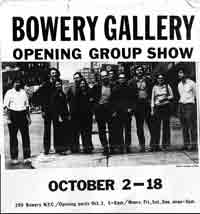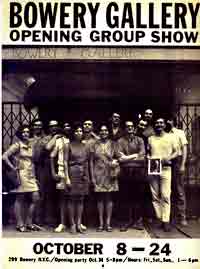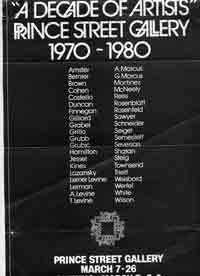Coops
by Robert Sivert and Donna Maria de Creeft

Flyer from the Bowery Gallery (1)

Flyer from the Bowery Gallery (2)

Flyer from the Prince Street Gallery Gallery
Robert Sievert:
In the late 1960's and early seventies a sense of unrest existed in many young artists. They were not happy with the development of the contemporary art world. After the abstract expressionistic explosion of the post war era the art world turned away from painting. Many young artists schooled by the masters of the abstract era returned to painting figurative images. Nowhere was this more evident than in the early artist-run galleries nestled together in Soho.
These galleries came out of a community of artists that began to form as the result of drawing groups as well as discussion clubs mostly on the lower eastside Early sites were artists' studios (Al Leslie) and the Educational Alliance. The idea of artist-run galleries was already established by the previous generation on 10th street, so it was natural for artists to experiment with running galleries. Artist-run galleries began to appear on the lower Bowery and the surrounding area. They were low-rent storefronts just like 10th street, basically clean, well-lit spaces. Not all galleries survived.
Focusing on four particular galleries: 1st Street, Bowery, Prince St. and Blue (once Green) Mountain Gallery that have been in existence for over thirty years. There are other coops, but these four have maintained a mutual history and a consistent reputation for artistic excellence as well as being known for a certain type of work, work that fits into a recognizable tradition.
In the early seventies, these galleries migrated to the same area of Soho from different parts of the city,and began to show art that was figurative, and humanistic. Most artists were young and developing. They Influenced each other and for the most part artists chose who would be in their galleries.
Nancy Grilikles, a founding member of First Street Gallery and now a leading member of Prince Street Gallery, remembers the formative years well. She remembers the excitement and enthusiasm of the artists who would come regularly to the friday night meetings at the Educational Alliance on East Broadway. Artists would be passionate about their issues. One incident stands out in her mind. At the end of a rather heated evening of discourse some one in the crowd shouted out "Fuck geometry!"
Grilikles brings up the point of artistic consistency and continuity. As the first coops were being formed they tended to be the products of groups of people sympathetic to each other's art. Groups often consisted of students of one particular teacher or school. Entry to a gallery meant that each artist would submit work to be evaluated by gallery members. This process helped galleries to achieve a particular individual identity.
Gallery dues have gone up, up, up as these galleries are now situated in an extremely "hot" art area. Five years ago when Blue Mountain, Prince Street and Bowery relocated to their current 25th Street location there were perhaps less than a half dozen other galleries on the block. Today 25th street is the main street of the Chelsea art world.
Another pioneer from the early years is Marion Lerner Levine. She joined Prince Street Gallery in 1971. remembers the tumult of the meetings at the figurative alliance. She felt that some artists were cruel and derisive of others. But out of this mix a movement was born. Artists gathered together to support one another and form galleries. Levine feels being a member of a coop means that no one is promoting you — you have to do your own promotion.
There are many considerations an artist faces in thinking about joining a coop. The artist and the gallery ideally should have a "fit", be right for each other. There are other coops who do not have the consistency and reputation the four focus galleries. Although there are many fine artists in these galleries, they clearly are outside a certain tradition that has flourished in the four aforementioned galleries.
Susan Grabel remembers that when she applied to Prince Street Gallery a group of gallery artists actually came and visited her studio. Over the years this process has been warped by considerations of finance and art world politics.
Grabel, a sculptor, printmaker and former member of Prince Street Gallery, was in the early days of Prince Street. She recalls the early years as an exciting productive time. She rattles off names of artists and tells how fabulous they and their work were. She had a strong sense belonging to a community that was productive and stimulating.
Most important for her was the demands of having to do a show on a regular basis. There is a sense of discipline that comes along with being in one of these galleries... one must produce a show on a regular basis, so that one must continue to work. After being in the scene for 17 years she decided she had gotten as much as she could from being in a coop and moved on. she has remained a disciplined worker and continues to work and show her art.
Marcia Clarke, director of Blue Mountain comments on the origins of the galleries: "Back then, the artists at First Street thought they were "realists" and later that they were perhaps the last holdouts for the cause. This did seem foreign to me and what attracted me to Blue Mountain was that it was eclectic. And thanks to Lucien [Lucien Day, founder and director of Green Mountain Gallery] it always had been. There were a number of people from Brooklyn College at First Street. Some influenced by Philip Pearlstein (maybe Nancy Grilikhes and Altoon Sultan among them) and Fred Badalamenti was on the faculty. Don't know who he had studied with. For a while there were a couple of Lenart Anderson clones, who later came into their own: Jim Lecky and Langdon Quin. Many students of Leland Bell in Prince and Bowery. A number of others came out of the Studio School. It would be interesting to examine the roots to see what propaganda the students were passing on and from whom."
For the Last five yearts I have been a member of the Blue Mountain Gallery and have sat through some excruciating meetings where the membership has been trying to decide on accepting new artists to fill a vacancy. The core group of members work really hard at maintaining a consistent image. Sometimes this works and sometimes it doesn't. But the upshot is that BlueMountain has a strong artistic identity
At a recent meeting of Blue Mountain we were looking at prospective artists. One member piped up "but it's abstract" . Although this person had been a member for over five years they were under the impression we were a strictly "realist gallery". A number of other members were taken aback. While there is no written policy as to what kind of gallery we are, it is generally felt that for the most part we are a painters' gallery. We talk about painters quality, but there is no written or clearly defined rules as to who we are. We also have a sculptor and a number of some of our artists sculpt as well as paint. It is a matter of each artist's interpetation as to what kind of gallery we are and at times there is agreement. In a way that is what makes it interesting and alive &mdash realist or abstract doesn't seem to be the issue. Somewhere in this mix there has been a continuity of an artistic tradition in all four of these galleries that continues into the future and reaches back in the rich history of the New York art world.
Donna Maria deCreeft:
Thoughts on the Coops
The art world has always been a difficult place to navigate and the uneasy relationship between the business of art and the creation of art hasn't changed much since Vasari wrote "The Lives of the Artists." Many great works of art were created by artists who had to scramble daily for patronage. Many artists, whose work sells for millions at auction, lived in obscurity and died in poverty. Every time has its challenge, and ours is the corporate, bottom-line mentality that values product over process. It's difficult for a creative person in any field to thrive and survive in a culture that has little interest in sustaining art forms that don't turn quarterly profits. It's now considered essential for artists to have business acumen as well as artistic ability, as if one set of skills must go with the other.
In the past there were legendary patrons, gallery owners and dealers who made life-long, highly personal, even parental commitments to their artists and secured their fame. There still might be some out there, but serendipitous discoveries are rare. Artists usually need some form of personal introduction just to get someone to look at their slides. Even when they get past the gatekeepers, many artists find commercial galleries are reluctant to take them on unless they come prepared with an impressive resume, their own list of clients, a proven track record of sales, and significant recognition by the press.
To be fair, running a commercial gallery is an expensive proposition and, I overheard one dealer say in all sincerity, "It's a tremendous commitment to take on an artist. It means you're responsible for making sure they earn a living." The coops aren't "all about business". They are places where different artists can have different goals. Coop members don't have to be equally savvy, or aggressive or interested in becoming "successful" by today's standards. There are many talented artists who choose relative obscurity because they prefer to spend their time making rather than marketing their work. In the coops, artists are responsible for their own living, benefit from the rewards of their own efforts and fit their careers to their own needs.
Over the years I've heard artists and dealers dismiss the coops for various reasons.
One is the lack of visibility. Another is lack of consistency and the accusation that they are second rate or "vanity" galleries. Coop galleries don't have huge advertising budgets, but they have loyal fans among people who know and care about art including curators, collectors, critics and other artists. Besides individual shows, the coops offer their artists opportunities to curate shows presenting political ideas or social commentary. Coop shows are frequently reviewed in the art magazines, local and national papers. New York times critic, Holland Cotter recently wrote about a show curated by Lowery Stokes- Sims at Ceres Gallery.
Coops don't always have a "presence", or director on premise. This is disadvantageous when selling work as artists are responsible for generating interest and finding their own clients, and without a dealer's or director's overarching vision the style of the gallery can be eclectic. It also means that artists are not subjected to someone else's aesthetic or financial agenda.
I believe the unfair judgment that cooperatives are inferior venues with second-rate artists has its source in the insecurity created by a system that judges success by wealth, access to power and exclusivity. Cooperatives are alternative spaces, and because they are open to all artists, the quality of the work is may be uneven. but that does not mean it is poor. Some artists begin their careers in the coops and move on to commercial galleries, others are represented by commercial galleries elsewhere and maintain their coop memberships, and some return to the coops after their experience, good or bad, with commercial galleries.
As for the tiresome pejorative, "Vanity Gallery" In fact, there is a long-standing tradition of artistic collectives. I like to think of the coops as the visual artist's version of off-off Broadway or the Bloomsbury Press, started by Virginia Woolf and her husband Leonard. And I can't imagine anyone thinking of "Citizen Kane" as a vanity production because Orson Welles wrote, directed, cast his friends in supporting roles and starred in it. Nor does one hold it against Edward Steichen that he showed the work of his mistress, Gerogia O'Keefe, or of his friends Arthur Dove and Marsden Hartley in his gallery.
I joined Blue Mountain Gallery in 1988. The coops were a lively presence in Soho in the 1970's and 80's. They championed figurative and landscape painting and I knew quite a few of the artists who belonged to them from the Studio school and the Art Student's League. Despite the fact that, or perhaps because I grew up in the art world (both of my parents were sculptors with long, successful careers) I felt ambivalent about entering it professionally, and it interested me that other children of well-known artists gravitated to the coops.
Joining the gallery meant becoming part of a community of artists who supported each other's efforts to grow and develop ideas. The gallery gave me the support I needed to present my work in all its painfully slow and sometimes awkward stages of transition from figurative to abstract. In the years that I belonged to Blue Mountain, lasting friendships and invaluable professional opportunities came my way. One of my colleagues encouraged me to submit a proposal a visiting artist residency at the University of Southern Maine, which I received. I had opportunities to show around the country through the gallery's traveling shows. I had four solo shows, and used one of my exhibition slots to mount a two-person show with a British artist I met on a trip to England. I participated in group shows at Blue Mountain and elsewhere, and took my turn as director. Having to work toward specific exhibition dates gave me the impetus to consolidate and conclude ideas. Handling sales, promotion, and preparing press materials gave me experience with the business end of the art world. Talking with visitors to the gallery and other artists who were showing was a source of invaluable information and feedback. I enjoyed sitting and contemplating the work of other artists and my own work away from the clutter and confusion of my studio.
While the cost and the time commitment of belonging to a coop is significant, the motivation to show work in a professional setting on a regular basis can't be underestimated. As democratic collectives where artists pool their resources, they keep artists from becoming isolated and feeling disconnected from the larger art world.
Cooperative galleries can't guarantee artists a living any more than commercial galleries, but they can guarantee them autonomy and the opportunity to develop work in their own time, on their own terms.
I stayed at Blue Mountain until 2006. It was becoming more difficult for me to make the necessary financial and time commitment. I felt it was time to move on.
Text copyright © 2007 Robert Sievert and Donna Maria de Creeft
 back to Contents page
back to Contents page